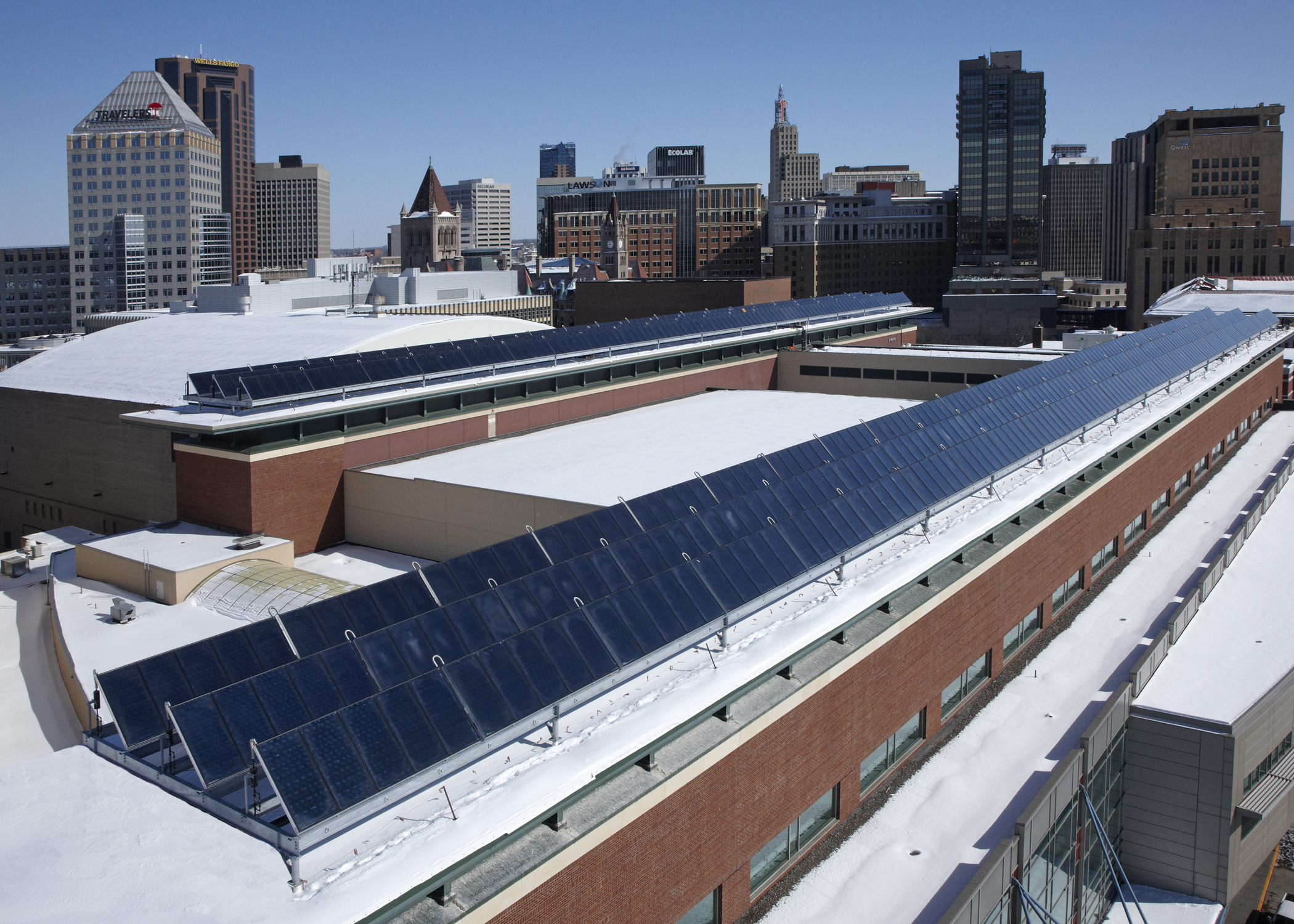
Renewable Thermal: Solutions and Policy for Decarbonization
May 28, 2020 by Ever-Green Energy
In the conversation about renewable energy, the electric power grid tends to receive most of the focus. Over 25% of all energy use in the US is attributed to heating and cooling, which has a significant impact on climate change. With 39% of global CO2 emissions related to energy coming from heating and cooling, decarbonizing the thermal energy sector has great potential. Currently, only 10% of thermal energy globally comes from renewable sources.
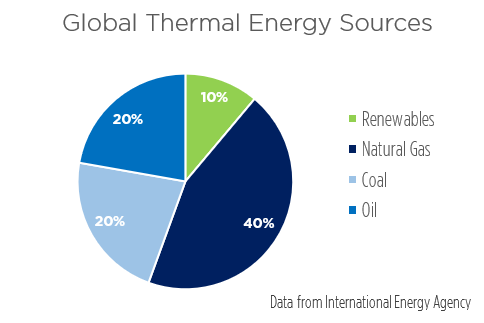
Thermal energy is used for heating and cooling buildings, domestic hot water, commercial cooking applications, and process and non-process heating and cooling in industrial systems.
Renewable thermal energy provides thermal energy from sources that replenish themselves over a short period of time or that use energy and resources that would otherwise be wasted or dissipate. Renewable thermal options, such as geoexchange or biomass, reduce fossil fuel use and carbon in thermal systems for buildings and industry. As solutions evolve, we anticipate additional attention will be given to overall greenhouse gas emission profiles, public health, and other meaningful outcomes.
To achieve the full potential of decarbonizing thermal systems, consideration should also be given to harnessing electricity with the lowest carbon footprint available to the grid or directly from renewable electricity, as well as storage solutions. We will not delve into these alternatives in this blog, but they are an important part of an efficient and holistic approach to rethinking our energy system.

Ever-Green Energy specializes in developing and advancing thermal energy systems, with cutting-edge renewable thermal alternatives being implemented or explored in our projects, including the Mission Rock project in San Francisco and the Towerside Innovation District in Minneapolis. As urgency to decarbonize thermal energy grows, it is important to consider emerging and established solutions in the renewable thermal energy market, including the resources available, the policy landscape creating change at the state level, as well as the drivers of these trends.
Implementing renewable thermal policies and applications has a number of benefits:
- Reducing greenhouse gas emissions
- Reducing pollution and improving public health
- Improving efficiency, especially when resources that would otherwise be wasted are captured and used in the energy process
- Encouraging renewable thermal energy storage and opening up the potential for electric power grid support services
- Creating jobs in the renewable energy sector and potentially stimulating domestic manufacturing of renewable technologies
Types of Renewable Thermal Resources
To help our readers consider the scope and potential of renewable thermal, we will outline some of the most prevalent solutions in the marketplace. These approaches have been defined as renewable by the US Department of Energy or the Environmental Protection Agency. This is not a comprehensive analysis of the viability or challenges of these solutions, nor is it intended to be a complete inventory of available alternatives.
Geoexchange
Ever-Green considers geoexchange to be an umbrella term for sources that can provide a low-grade heat source (reservoir that can supply thermal energy) and heat sink (reservoir that can receive thermal energy). Geothermal energy is the most notable technology in this category, but systems like bay water exchange and aquifer thermal energy storage are also considered geoexchange technologies. Read more about these in our previous geoexchange blog.


Solar Thermal
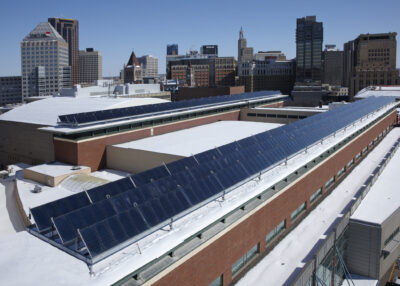
Energy from the sun can be captured through both electric energy and thermal energy. Unlike photovoltaic solar panels, that capture electric energy, solar thermal panels collect the heat and use it to provide space heating and domestic hot water to a building or network of buildings. The Ever-Green team developed the country’s largest solar hot water application atop the Saint Paul RiverCentre as part of the Solar America Cities program and the American Recovery and Reinvestment Act. The International Energy Agency’s 2019 report, Solar Energy: Mapping the Road Ahead, summarizes the current and future state of solar thermal technologies and implementation.
Biomass

Power that is generated through the combustion of organic material is classified as biomass. Generally waste organic material is used in the biomass process, such as the remnants of produce harvesting or tree waste, as is used in Saint Paul’s district energy system. This organic material is combusted, and the heat produced from this reaction is transferred through water to heat buildings. Steam from this combustion process can also be used to heat buildings or to move turbines for electricity production. Capturing the steam byproduct from electricity production is nearly twice as efficient and is known as combined heat and power. Read more about biomass energy on the US EPA’s website.
Biofuel
In systems that currently use fuel oil, fuels that are made from bio-based inputs can be a good alternative. These are known as biofuels and most commonly include ethanol and bio-diesel. Biofuels are produced by transforming biomass directly into a liquid fuel. Systems can be engineered to operate specifically on biofuels, but current research is focused on developing “drop-in” fuels, which can be used without modification in systems that were designed to use petroleum or other non-renewable fuels. Similar to biomass, these fuels can be used for electric, thermal, combined heat and power, or vehicle applications. Find more information about biofuels curated by the US Department of energy on their website.
Biogas
According to the International Energy Agency, natural gas is the most common source of fuel for thermal energy systems, so much work is being done to identify alternative gases that are already being produced by biological processes. Biogas is the gas produced from the decomposition process of organic material, when microorganisms break down the organic material components. These biogases can either be used as-is—generally with high methane and carbon dioxide concentrations—or can be refined to meet requirements of the natural gas distribution system to be considered a renewable alternative to natural gas. It is often sourced from agricultural or livestock operations where gases are a natural byproduct but can be captured from any organic processes that release useful waste gases. Some organizations are purchasing renewable natural gas for direct use and others are participating in emerging offset programs. The US EPA covers biogas on their anaerobic digestion page, which is one method of producing and using biogas.
Renewable Hydrogen Gas
Another type of gas being implemented for thermal uses is hydrogen gas. Hydrogen occurs naturally but can be produced and captured through hydrolysis, which separates the hydrogen from the oxygen in water molecules, taking water and turning it into hydrogen and oxygen as outputs. The hydrolysis process requires energy inputs, so using renewable electricity to power the process makes the hydrogen creation a renewable process. Once the hydrogen gas is created or captured, it can be used directly for applications like fuel cell vehicles, or it can be mixed with natural gas and used in existing natural gas infrastructure. The US Department of Energy has a division dedicated to furthering hydrogen and fuel cell technologies.
Policy changes can move the needle on renewable thermal implementation
In the pursuit of carbon neutrality, the emphasis on renewable electricity can obscure the effectiveness of renewable thermal applications. On a recent project, a geoexchange opportunity was estimated to save 40% of carbon dioxide emissions from each building, however, there were not equivalent subsidies or incentives for this renewable thermal alternative. Since many developers and planners aren’t as familiar with renewable thermal applications, in this case study, the developers were more compelled to focus on renewable electricity. A more robust policy and incentive approach would allow site developers to focus on the solutions that save the most carbon and provide the most benefits long-term.
In most states, thermal resources are not subsidized like electrical renewable energy sources in current policies, so policy interventions that work to encourage the knowledge and integration of renewable thermal applications will have a valuable impact on the next phase of decarbonization. Many different policy approaches are possible.
Renewable Portfolio Standard Integration
Many states have Renewable Portfolio Standards that require them to produce a certain percentage of their energy from different renewable sources. While most of these standards were originally created specifically for electricity, many have been expanded to include renewable thermal standards. This is the case for 12 states and the District of Columbia.
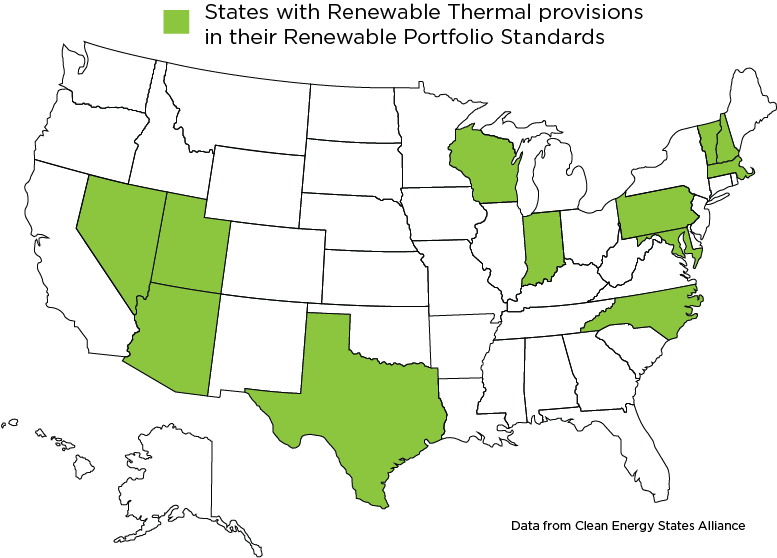
Incentive Structures
Another policy approach is to provide financial incentives to residents or businesses to install and integrate renewable thermal energy. New York has an incentive-based policy that covers a portion of the installation costs for such technologies, ranging from 45-75% of installation fees covered. France offers tax exemptions and rebates for renewable thermal projects, which was used to support over 3,600 projects between 2009 and 2015.
Other Renewable Thermal-Focused Policy Structures
Other policy mechanisms also exist to support the growth of renewable thermal technology use. Since renewable thermal receives much less funding and coverage, many residents or businesses know little about it, creating an informational barrier to implementation. This is changing as more emphasis is being placed on decarbonization of the natural gas system and its end uses. Additional programs that are currently available to increase adoption of renewable thermal resources include:
- Technical assistance programs: An effective tool to overcome lack of familiarity with renewable thermal. This can be useful during design processes for buildings and campuses.
- Building code improvements: In states like Minnesota, the statewide policies for building codes make it extremely difficult for communities and local government to apply higher expectations for efficiency and renewable integration. Current efforts are underway to change this policy in Minnesota, so new developments can be more adaptable to emerging technology and best practices. Building codes should establish the floor of minimum efficiency requirements. Unfortunately, too often building codes are used to do just the opposite. They are used to establish a ceiling of maximum efficiency measures that can be implemented on a project or in a community.
- Research and development: Although many renewable thermal technologies are already proven and feasible, it is critical that continued research and development are prioritized to adapt solutions for changing building, community, and business needs as well as to make existing solutions more efficient, more cost-effective, and easier to integrate into projects. Research grant programs can help to ensure that renewable thermal continues to move in a smarter and more efficient direction.
Carbon-Focused Policies
The motivation for developing and integrating renewable thermal energy is at its core about reducing greenhouse gas emissions. Higher-level policies that share this goal can also help to support renewable thermal as well. Carbon pricing policies like cap and trade or carbon tax systems would provide indirect incentives to install renewable thermal systems. Renewable energy credits—where energy offsets are purchased—can do the same, especially if a policy specifically separates renewable thermal credits. M-RETS recently created a renewable energy credit system for renewable natural gas.
Our Efforts to Promote Renewable Thermal Solutions
With the focus on shifting electricity to renewable sources fading into a more holistic consideration of decarbonization, the thermal sector will hold the next wave of opportunities for carbon reduction.
At Ever-Green, we seek partners and projects that are working toward environmental stewardship and thermal system decarbonization. Renewable thermal technologies are often not only compatible with the systems we are developing or advancing, but they are the most responsible solutions in terms of efficiency, long-term cost for customers, and greenhouse gas emissions.
Renewable thermal technologies are used in systems we currently operate and are being implemented and considered in a number of active projects:
- Learn more about the biomass and solar thermal in our District Energy St. Paul, St. Paul Cogeneration, and Environment Wood Supply profiles.
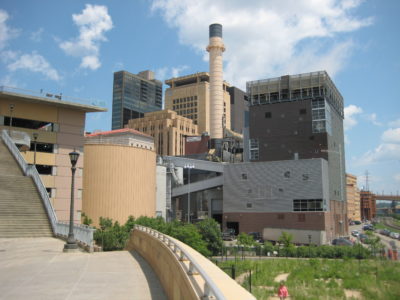
- Learn more about aquifer thermal energy storage being considered at Towerside Innovation District in Minneapolis and bay water exchange at Mission Rock in San Francisco in our blog, Technology Spotlight: Geoexchange Energy Systems.

- Read about Ever-Green President and CEO Ken Smith’s takeaways from his trip to Germany that focused on integrated energy systems and cross-sector solutions, including biomass, solar, biogas, and combined heat and power.
- Read more about Ever-Green’s philosophy on beneficial electrification in our blog, as we look for solutions where renewable thermal can be paired with renewable electricity to achieve net zero carbon.
While renewable thermal technologies and applications continue to evolve, most technologies are ready to be deployed. Policies that better encourage thermal technology implementation are needed to allow these applications to make it to market more readily. Complete decarbonization will involve utilization of all available technologies, including interaction between renewable thermal and beneficial electrification strategies, and Ever-Green is committed to working on holistic energy and policy solutions.




